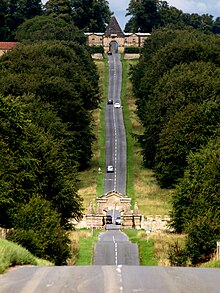Carrmire Gate
The gate with its towers and flanking walls was constructed in 1725, to a design by Nicholas Hawksmoor. It is the first in a succession of structures encountered by a visitor travelling to the house, but was the last built. It is smaller and more decorative than the next, the Pyramid Gate. At the edge of the estate, it would have originally marked the transition from open fields to the estate's deer park; although in a dip, the openness of the landscape would have made it a prominent landmark.

John Dixon Hunt describes the gate as "very theatrical – pure stage set and, since its extent is so short, clearly incapable of doing any defending at all". Vaughan Hart describes it as "an exercise in effecting ... feelings of awe and wonder in the visitor".
The structure is in the Italianate style, reminiscent of the work of Giulio Romano. It is built of limestone. The gateway has a round arch with a triple keystone and an open pediment, flanked by square rusticated piers, surmounted by six pyramids. On each side is an embattled wall extending for about 30 metres (98 ft), and ending in mock medieval turrets, with two stages, cruciform arrow slits and embattled parapets. It has been Grade I listed since 1954.
See also
References
- ^ Fisher, Celia (2022). 9780262581318. Reaktion Books. ISBN 9781789146363.
- ^ Finch, Jonathan; Giles, Katherine (2007). Estate Landscapes : Design, Improvement and Power in the Post-medieval Landscape. Boydell & Brewer. ISBN 9781843833703.
- ^ Levine, Neil (2009). Modern Architecture: Representation & Reality. Yale University Press. ISBN 9780300145670.
- ^ Dixon Hunt, John (1992). Gardens and the Picturesque. MIT Press. ISBN 9780262581318.
- ^ Hart, Vaughan (2008). Sir John Vanbrugh: Storyteller in Stone. Yale University Press. ISBN 9780300119299.
- ^ Historic England. "Carrmire gates, wall and end turrets (1174223)". National Heritage List for England. Retrieved 28 April 2024.
- ^ Grenville, Jane; Pevsner, Nikolaus (2023) [1966]. Yorkshire: The North Riding. The Buildings of England. New Haven and London: Yale University Press. ISBN 978-0-300-25903-2.